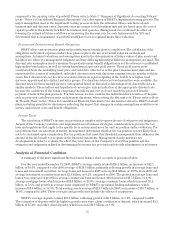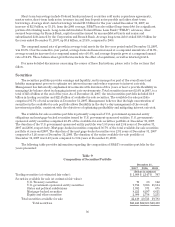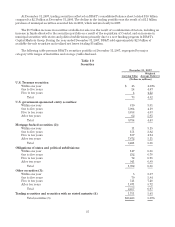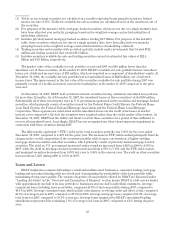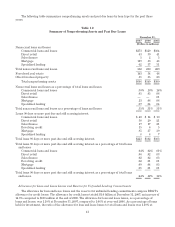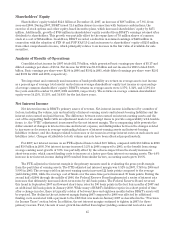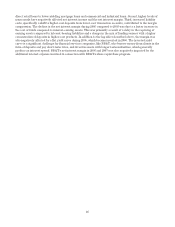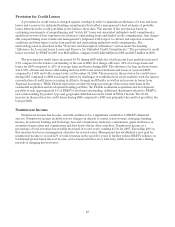BB&T 2007 Annual Report Download - page 39
Download and view the complete annual report
Please find page 39 of the 2007 BB&T annual report below. You can navigate through the pages in the report by either clicking on the pages listed below, or by using the keyword search tool below to find specific information within the annual report.BB&T’s loan portfolio, excluding loans held for sale, increased $8.0 billion, or 9.6%, as compared to 2006.
Average total loans and leases for 2007 increased $8.6 billion, or 10.9%, compared to 2006. The growth in the loan
portfolio was primarily a result of strong internal growth in the commercial and industrial lending portfolio, as
well as growth in the mortgage and specialized lending portfolios. The growth in average loans during 2007,
includes the impact of the acquisitions of Main Street Banks, Inc. (“Main Street”) and First Citizens Bancorp
(“First Citizens”), which were acquired in 2006, and Coastal and AFCO, which were acquired during 2007.
Average commercial loans and leases increased $3.5 billion, or 9.0%, in 2007 as compared to 2006. Overall the
commercial loan and lease portfolio showed strong growth during 2007. The mix of the commercial loan portfolio
has shifted somewhat, as commercial real estate lending has slowed due to a slower real estate market. This has
been offset by an increased focus on commercial and industrial loans. Average consumer loans increased $1.2
billion, or 5.6%, as compared to 2006, which includes increases in direct retail loans of 3.8%, sales finance loans of
9.6% and revolving credit loans of 9.7%. The pace of growth in the direct retail loan portfolio slowed further in
2007, due to a slowdown in the residential real estate market, which decreased demand for home equity loan
products. Sales finance loans and revolving credit reflected solid growth rates during 2007. BB&T concentrates
its efforts on the highest quality borrowers in both of these product markets. Average mortgage loans increased
$2.0 billion, or 13.0%, compared to 2006. Management views mortgage loans as an integral part of BB&T’s
relationship-based credit culture. BB&T is a large originator of residential mortgage loans, with 2007 originations
of $11.9 billion. To improve the overall yield of the loan portfolio and to mitigate interest rate risk, BB&T sells
most of its fixed-rate mortgage loans and some of its adjustable-rate mortgage loans in the secondary market. At
December 31, 2007, BB&T was servicing $32.1 billion in residential mortgages owned by third parties and $18.9
billion of mortgage loans owned by BB&T, including $18.2 billion classified as mortgage loans and $669 million
classified as securities available for sale. Average loans originated by BB&T’s specialized lending subsidiaries
increased $1.9 billion, or 58.8%, compared to 2006. The growth in the specialized lending portfolio was driven by
the acquisition of AFCO as well as strong internal loan growth as management views these businesses as
providing an attractive risk-adjusted return for BB&T and has grown this portfolio at a faster pace than the
overall lending portfolio.
The average annualized FTE yields on commercial, consumer, mortgage and specialized lending subsidiary
loans for 2007 were 7.76%, 7.54%, 5.99% and 13.27%, respectively, resulting in a yield for the total loan portfolio of
7.67%. The FTE yields on commercial, consumer, mortgage and specialized lending subsidiary loans for 2006 were
7.78%, 7.23%, 5.70% and 15.22%, respectively, resulting in a yield for the total loan portfolio of 7.53%. The 14 basis
point increase in the average yield on loans resulted primarily from the repricing of maturing loans with lower
yields that were replaced with higher-yielding loans and leases. In addition, the FTE yield on the total loan
portfolio was positively affected by a change in the mix of loans, with a higher percentage of higher-yielding loans
originated in the specialized lending group in 2007 compared to 2006. The prime rate is the basis for pricing many
commercial and consumer loans and was 7.25% at year-end 2007. The average prime rate in effect during 2007 and
2006 was 8.05% and 7.96%, respectively. The Federal Reserve Board left rates unchanged from June 2006
through September 2007, but cut rates by 100 basis points over the last four months of 2007 in response to a
slowing economy, challenges in the residential real estate markets, and disruptions in other financial markets.
The Federal Reserve continued to aggressively lower rates in early 2008 with two cuts totaling 125 basis points
and, as of February 1, 2008, the prime rate was 6.00%. Therefore, the FTE yield on the loan portfolio is expected
to decline as loans mature or reprice.
Asset Quality and Credit Risk Management
BB&T utilizes the following general practices to manage credit risk:
Šlimiting the amount of credit that individual lenders may extend;
Šestablishing a process for credit approval accountability;
Šcareful initial underwriting and analysis of borrower, transaction, market and collateral risks;
Šongoing servicing of individual loans and lending relationships;
Šcontinuous monitoring of the portfolio, market dynamics and the economy; and
Šperiodically reevaluating the bank’s strategy and overall exposure as economic, market and other
relevant conditions change.
39








